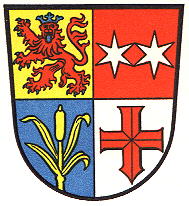Groß-Rohrheim: Difference between revisions
Jump to navigation
Jump to search
Knorrepoes (talk | contribs) No edit summary |
Knorrepoes (talk | contribs) m (Text replace - "[[Literature" to "{{media}} [[Literature") |
||
| Line 18: | Line 18: | ||
The second two stars taken from the arms of the Counts of Erbach. Both families ruled the village for a period during the 14th-17<sup>th</sup> century. The cross is the symbol of the Lorsch Abbey, to which the village belonged for many centuries. The reed in the third quarter is a canting element (Rohr=reed). | The second two stars taken from the arms of the Counts of Erbach. Both families ruled the village for a period during the 14th-17<sup>th</sup> century. The cross is the symbol of the Lorsch Abbey, to which the village belonged for many centuries. The reed in the third quarter is a canting element (Rohr=reed). | ||
{{media}} | |||
[[Literature]] : Stadler, K. : Deutsche Wappen - Bundesrepublik Deutschland. Angelsachsen Verlag, 1964-1971, 8 volumes. | [[Literature]] : Stadler, K. : Deutsche Wappen - Bundesrepublik Deutschland. Angelsachsen Verlag, 1964-1971, 8 volumes. | ||
Revision as of 22:13, 8 July 2014
| Heraldry of the World Civic heraldry of Germany - Deutsche Wappen (Gemeindewappen/Kreiswappen) |
GROSS-ROHRHEIM
State : Hessen
District (Kreis) : Bergstrasse
Official blazon
Origin/meaning
The arms were designed and granted in 1930 and are based on the seal of the local council from 1613. The first quarter shows the lion of Katzenelnbogen.
The second two stars taken from the arms of the Counts of Erbach. Both families ruled the village for a period during the 14th-17th century. The cross is the symbol of the Lorsch Abbey, to which the village belonged for many centuries. The reed in the third quarter is a canting element (Rohr=reed).
Contact and Support
Partners:
Your logo here ?
Contact us
© since 1995, Heraldry of the World, Ralf Hartemink 
Index of the site
Literature : Stadler, K. : Deutsche Wappen - Bundesrepublik Deutschland. Angelsachsen Verlag, 1964-1971, 8 volumes.











